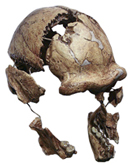Peking Man and Awa Maru
Maru moved a large amount of wealth
Treasure lost aboard sunken ships tends to be irreplaceable and this, along with the treasure's story, adds to its value whether monetary or priceless. Famous treasure finds that manage to capture the world's attention are often ornate crafted gold and jewelry attached to legends which demonstrate an empire's wealth and power. At times, however, the lost treasure is far more rare and valued by world heritage than any precious metal or gem. One example of this in particular are remains of the Peking man presumed missing when a ship sunk during the second world war. The fossils are profound to humanity, dating to anywhere between three-hundred to almost eight hundred-thousand years ago, identified to be part of none other than Homo erectus ancestors. Several attempts to locate and restore the missing artifacts have turned up dry and the Peking man's location is unfortunately still unknown.

Excavated from a historic site near Beijing, China in the late 1920's with further discoveries into the thirties solidified the Peking man's fossil identification. Multiple skulls, teeth, and stone tools found in the area provide a glimpse into the lives of primitive Chinese ancestors. The fossils became a prized treasure of mankind after research studies demonstrated their significance, and were protected just as other valuable treasures of the time. Resources for many countries in the second world war were spread thin, and as casualty affected more people and supplies it became increasingly necessary to make the most of what resources were available. This ultimately included refitting machinery and ships for war purposes, using them to facilitate the effort for a prolonged period. An infamous passenger ship called the Awa Maru is a testament to the lengths Japan would go at a time when principal resources, including plundered treasures, were running out.
The five-hundred foot long vessel initially built for transporting passengers was quickly transformed not long after completion to haul a large amount of ammunition and reinforcements, then serviced for missions to follow. It fell victim to torpedo attack, underwent structural repairs, and was eventually recommissioned to supply relief in support of Red Cross efforts. In its second-to-last voyage, the Maru moved a large amount of wealth in gold, silver and platinum to Singapore. With the destination ultimately being Thailand, eyewitness speculations also suggested the Peking man artifacts were part of the same cargo.
The theory describes Awa Maru's last voyage to be escorting a large shipment of precious metals along with the Peking man fossils and a few other invaluable artifacts. In fact, the Chinese government spent multiple millions in recovery efforts to salvage the ship, believing this to be true according to their own records. However, hijacked communications by United States intelligence tells a completely different story. Recordings and transcripts identify Awa Maru off-loading its precious cargo in Singapore well before sinking. Some eyewitness reports corroborate this fact by describing a lesser valued cargo of rubber and copper aboard the ship as it left Singapore. If the precious cargo was off-loaded before the Maru's last departure then it is likely to believe the Peking fossils were too. China's salvage efforts managed to locate the ship, then reported nothing of value was recovered. This further supports the fact treasure was off-loaded beforehand or that possibly, it was part of a strategic plan.
Another, more accepted theory, traces the missing fossils to a United States Marines ship named the SS President Harrison. Captain Orel Pierson reports detail a journey from Chingwangtao to Manila transporting several hundred marines and a fourteen-hundred ton cargo. The ship was tracked by Japanese forces and then captured, sending the crew to prison camps and the cargo to an unknown location. According to record, the Peking man fossils were among cargo confiscated which originally were intended to travel by safe passage from Qinhaungdao to the United States. This is the last known and most credible report to date places the fossils traveling from Peking Union Medical College by rail to port. Meaning, the fossils must have survived port in Singapore aboard the Awa Maru and nearly four-thousand mile journey to Beijing before leaving the college.
